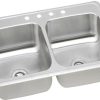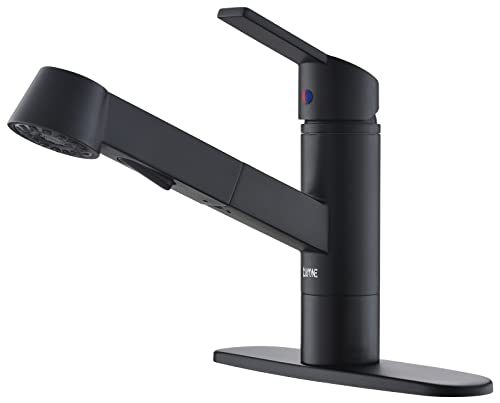In the modern kitchen, convenience, and style go hand in hand. As technology advances, touchless kitchen faucets have become one of the most sought-after fixtures. These innovative faucets offer a hands-free approach to water flow, making everyday tasks in the kitchen a breeze. A touchless kitchen faucet is a must-have addition if you want to upgrade your kitchen and enhance your culinary experience. In this article, we will delve into the world of touchless kitchen faucets, exploring their benefits, features, and the top options available in the market.
SPECIFICATIONS
Special Features: Touchless Item Weight: 9.8 Pounds
Product Dimensions: 10 x 5.81 x 21.75 inches
Handle Type: Sensor
Style: Spring – Touchless
TODAY’S BEST DEALS
 REASONS TO BUY
REASONS TO BUY
- Hygienic: Touchless operation helps to maintain cleanliness and prevent the spread of germs and bacteria.
- Convenience: Hands-free control allows for easy operation, especially when hands are dirty or occupied.
- Water Conservation: Automatic shut-off feature helps conserve water by preventing unnecessary usage.
- Customizable Settings: Many touchless faucets offer adjustable settings for water temperature, flow rate, and spray patterns.
- Modern Design: Sleek and contemporary appearance adds a stylish element to the kitchen decor.
REASONS TO AVOID
- Higher Cost: Best touchless kitchen faucets can be more expensive than traditional ones.
- Power Dependency: Touchless faucets require a power source, such as batteries or electricity, which may need regular maintenance or replacement.
- Installation Complexity: Installation may require professional assistance, especially if modifications to plumbing connections are necessary.
- Sensor Accuracy: Some touchless faucets may have occasional issues with sensor activation, leading to inconsistent performance.
- Learning Curve: Users may need time to adapt to the touchless operation and find the optimal hand positioning for sensor activation.
Introduction
The kitchen is the heart of every home, and the right faucet can significantly enhance its functionality and aesthetics. Touchless kitchen faucets are revolutionizing how we interact with water in the kitchen. With their motion sensor technology, these faucets allow you to control water flow with a simple wave effortlessly. Gone are the days of struggling to turn the tap on and off with messy hands or juggling between utensils and water controls. Touchless kitchen faucets provide a hygienic and convenient solution for busy households.
The Advantages of Touchless Kitchen Faucets
Touchless kitchen faucets offer numerous advantages, making them an ideal choice for modern homes. Let’s explore some of these benefits:
Improved Hygiene
One of the primary advantages of touchless kitchen faucets is their contribution to improved hygiene. You reduce the risk of cross-contamination between raw ingredients and other surfaces by eliminating the need to touch the faucet handles. This feature is especially beneficial when taking raw meat, eggs, or dough, where strict hygiene is crucial.
Water Conservation
Touchless kitchen faucets are designed to optimize water usage. The sensors detect your presence and activate the water flow only when needed, automatically shutting off when no longer use. This helps conserve water and reduces water bills while promoting eco-friendly practices in your home.
Convenience and Accessibility
With touchless technology, operating the faucet becomes effortless. Whether your hands are full with groceries, dirty from cooking, or even if you have limited mobility, you can quickly turn the water on and off without any physical contact. This convenience ensures a seamless and enjoyable cooking experience for everyone.
Enhanced Style and Aesthetics
In addition to their functionality, touchless kitchen faucets are available in various styles and finishes. Whether you prefer a sleek modern design or a classic and elegant look, a touchless faucet will perfectly complement your kitchen decor. These faucets serve as a statement piece, adding a touch of sophistication and luxury to your culinary space.
Key Features to Consider
When selecting the best touchless kitchen faucet for your home, it’s essential to consider the following key features:
Sensor Accuracy
The accuracy of the sensor is crucial for seamless operation. Look for faucets with advanced sensor technology that detect motion quickly and accurately to avoid frustration. A high-quality touchless kitchen faucet will have sensitive sensors to see your hand movements reliably, ensuring a smooth and efficient user experience.
Water Flow Control
Consider the options for water flow control offered by the touchless faucet. Look for models that allow you to effortlessly adjust the water temperature and flow rate. Some faucets even offer preset modes for different tasks, such as filling a pot or rinsing fruits and vegetables, providing added convenience and versatility.
Durability and Quality
Investing in a durable, high-quality, touchless kitchen faucet is essential for long-term satisfaction. Opt for faucets made from robust materials such as stainless steel or brass, as they resist corrosion and wear. Additionally, check customer reviews and ratings to ensure that the faucet you choose is known for its reliability and durability.
Battery Life
Most touchless kitchen faucets operate using batteries to power the sensors. Consider the battery life and the ease of replacing them when needed. Look for faucets that offer long-lasting battery performance to minimize the frequency of replacements and ensure uninterrupted operation.
Installation and Maintenance Tips
Installation Tips
Follow these steps to install your touchless kitchen faucet properly:
Step 1: Gather the necessary tools and materials
Before starting the installation, collect all the tools and materials mentioned in the manufacturer’s instructions.
Step 2: Shut off the water supply
Locate the main water supply valve under the sink and turn it off to prevent water flow during the installation.
Step 3: Remove the old faucet
Disconnect the supply lines and remove the old faucet carefully. Clean the area thoroughly to ensure a clean surface to install the new touchless kitchen faucet.
Step 4: Install the touchless faucet
Follow the manufacturer’s instructions to install the touchless faucet. Typically, this involves placing the faucet body through the mounting hole in the sink and securing it with a mounting nut or bracket. Ensure that the faucet is appropriately aligned and leveled.
Step 5: Connect the water supply lines
Attach the water supply lines to the appropriate valves on the touchless faucet. Use an adjustable wrench or pliers to tighten the connections, ensuring they are secure but not over-tightened. Double-check for any leaks.
Step 6: Check for leaks
Once the faucet is installed and the water supply lines are connected, turn on the main water supply valve. Slowly open the touchless tap and check for any leaks around the connections. If you notice any leaks, tighten the connections or consider using a plumber’s tape to create a better seal.
Maintenance Tips
To keep your touchless kitchen faucet in optimal condition, follow these maintenance tips:
Tip 1: Clean the sensor regularly
The sensor on the touchless faucet can accumulate dirt and debris over time, affecting its sensitivity. Regularly clean the sensor area with a soft cloth or sponge to ensure proper functionality.
Tip 2: Avoid using harsh chemicals
Avoid using abrasive or harsh chemicals that can damage the finish when cleaning the faucet. Instead, use mild soap or dishwashing liquid and warm water to clean the surface.
Tip 3: Check and replace batteries
Most touchless faucets operate on batteries. Periodically check the battery level and replace them when necessary. Follow the manufacturer’s instructions for battery replacement.
Tip 4: Inspect and clean the aerator
The aerator at the end of the faucet spout helps regulate water flow and prevent splashing. Remove the aerator and clean it periodically to remove any mineral deposits or debris that may affect water flow.
Tip 5: Address any leaks promptly
If you notice any leaks or drips from the touchless faucet, address them promptly. Check the connections and tighten them if needed. If the issue persists, consider contacting a professional plumber for assistance.
Frequently Asked Questions (FAQs)
Can I install a touchless kitchen faucet, or need professional help?
If you have basic plumbing skills, installing a touchless kitchen faucet can be done as a DIY project. However, if you need more clarification or are uncomfortable with the process, it’s advisable to seek professional assistance to ensure proper installation.
How long do the batteries in touchless kitchen faucets last?
The battery life of touchless kitchen faucets can vary depending on usage and the type of batteries used. On average, batteries can last anywhere from six months to two years. Using high-quality batteries and keeping spares on hand is recommended to ensure uninterrupted operation.
Can touchless kitchen faucets be used with hot water?
Yes, touchless kitchen faucets are designed to work with hot and cold water. Most models have temperature control options that allow you to adjust the water to your desired temperature.
Are touchless kitchen faucets more prone to malfunctions compared to traditional faucets?
Touchless kitchen faucets are designed with advanced technology and undergo rigorous testing to ensure reliability. While malfunctions can occur with any tap, reputable touchless models are built to withstand daily use and provide long-lasting performance.
Are touchless kitchen faucets water-efficient?
Yes, touchless kitchen faucets are known for their water efficiency. The sensors activate the water flow only when needed, reducing wastage and promoting water conservation. Some models offer features like flow rate control, further optimizing water usage.
Conclusion
Investing in the best touchless kitchen faucet is a game-changer for your culinary experience. The convenience, hygiene, and style they offer make them a popular choice among homeowners. By eliminating the need to touch the faucet handles, these innovative fixtures provide a seamless and hygienic water flow, making cooking and cleaning tasks a breeze. When selecting the right touchless kitchen faucet for your home, consider the key features, such as sensor accuracy, water flow control, durability, and battery life. With the top options available in the market, you can find a touchless faucet that combines functionality, style, and durability to elevate your kitchen.















